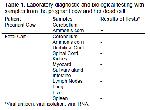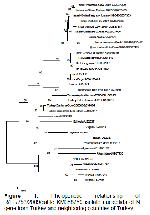On 20 May 2009, clinical signs of yawning, bellowing, incoordination, decreased feeling in hind limbs, loss of tail movement, drooling saliva, "cud-dropping", inability to stand, hypersensitivity, and aggression followed by paralysis were observed in a ten year old pregnant holstein cow. She had been bitten by a dog one month earlier. Four days later, she calved a dead male calf. The cow died a day later after parturition. The skull of the cow and her dead male calf were admitted to Elazığ Veterinary Research Control Institute for rabies diagnosis.
Reference methods were used for post-mortem laboratory confirmation of rabies infection of the holstein cow4. The fluorescent-antibody test (FAT) was positive on the cow's brain specimen (Table 1), and rabies was isolated in cow's Cerebellum and Ammon's corn by inoculation of suckling mice. Viral RNA extraction, reverse transcription (RT) and PCR were performed on brain sample specimens, hereinafter2 described. The dead male calf was autopsied. There was no autolysis and putrefaction. There was congestion in the lungs and petechial haemorrhages in the endocardium.

Büyütmek İçin Tıklayın |
Table 1: Laboratory diagnostic and biological testing with samples from the pregnant cow and her dead calf |
Cerebellum and Ammon's corn samples were collected following the opening of the skull belong the cow. Ammon's corn, cerebellum, spinal cord, umbilical cord, salivary gland, lymph nodes, kidney, myocardia, lung, liver, intestine and spleen were collected belong the dead calf in a necropsy room (Table 1).
Clinical and post mortem observation may only lead to a suspicion of rabies because signs of the disease are not characteristic and may vary greatly from one animal to another12. The only way to perform a reliable diagnosis of rabies is to identify the virus or some of its specific components using laboratory tests. The methods vary in their efficiency, specificity and reliability. They are classically applied to brain tissue, but they can also be applied, though less effectively, to other organs3,13,14.
Rabies laboratory diagnosis using pregnant cow and in fetal calf samples was according to (WHO, OIE) recommendations using reference methods2-4,14. The most widely used test for rabies diagnosis is the FAT, which is recommended by both WHO and OIE4,14. This test may be used directly on a smear, and can also be used to confirm the presence of rabies virus in cow and in fetal calf samples of mice that have been inoculated for diagnosis.
The RT-PCR assay was performed as described by Heaton et al.2 with modifications. The RT-PCR amplicons were resolved by electrophoresis on 1.5% agarose gels, stained with ethidium bromide (0.5 μg/mL), visualized and photographed by using a Thermo Hybaid Gel Grab imaging system. After electrophoresis, a specific 606 bp amplicon was observed in two cow samples whereas, specific 606 bp amplicon and 582 bp amplicon was not observed in any of the calf samples analyzed. PCR products were purified by a QIA quick gel extraction kit (Qiagen) and sequenced by ABI 3130xl genetic analyzer (Applied Biosystem, USA). The obtained sequence was compared and aligned with previously published Rabies virus sequences15 by using MEGA 516. MEGA 5 was also used to draw the amino acid based phylogenetic trees using the neighbor-joining method, 1000 bootstrap replicates were performed for analysis to assess the likelihood of the tree construction (Figure 1).

Büyütmek İçin Tıklayın |
Figure 1: Phylogenetic relationship of R/EL/753/2009/cattle KM058759 isolate nucleotids of N gene from Turkey and neighboring countries of Turkey. |
Rabies diseases diagnosed in the cow. Rabies Virus isolated in mouse inoculation test (Table 1). Rabies virus antigens and specific virus gens observed FAT and RT-PCR. The dead male calf was made post mortem examination. There was congestion in the lungs and petechial haemorrhages in the endocardium. Ammon's corn, cerebellum, spinal cord, umbilical cord, salivary gland, lymph nodes, kidney, myocardia, lung, liver, intestine and spleen were collected in a necropsy room. Fluorescent antibody test, Hemi nested RT- PCR and the mouse inoculation test were made for rabies virus diagnosis for this tissues. Rabies virus not isolated in the mouse inoculation test. Rabies virus antigens and specific virus gens not observed FAT and RT-PCR (Table 1). Partial nucleotid sequence of the positive primary PCR amplification was identified from the cow brain sample and published in GenBank with TR/EL/753/2009/cattle KM058759 code. Sequencing results of the positive primary PCR amplifications according to the partial nucleoprotein N gene 0-510 sequences confirmed that the isolate is rabies virus (RABV) by NCBI Programme. Phylogenetic analysis of RABV identified. As a result, nucleotid sequence of the isolate were found as identical with the isolates obtained from province isolates, as well as related with isolates sequences from neighboring countries of Turkey in the Middle East (Figure 1).
Transmission of infection to the fetus during pregnancy, although theoretically it might lead to immune tolerance and persistent virus carriage in the affected offspring, is nearly always an unimportant matter from the epidemiological point of view. With most viruses and in most species, primary infections during pregnancy are uncommon under natural circumstances. Persistent viruses are sometimes reactivated during pregnancy (e.g. malignant catarrhal fever virus in the wildebeest), but for most viruses this does not appear to be an important source of fetal infection. The virus must be present in the blood of the pregnant animal at the right stage of gestation, and it must reach the placenta and be either carried across, leak across, or grow across this barrier to reach the fetus. The placenta is the obvious route for passage of an infectious agent from mother to offspring, but infection directly from oviduct or uterine wall would also be possible. In any case, the fetus must not be unduly damaged, and throughout this process the virus must contend with both maternal and fetal immune responses17.
There is little information available about the potential vertical transmission of rabies and the outcome for neonates born to rabid mothers. This hampers informed choice concerning route and conditions of delivery by physicians for such cases, which mostly occur in places where medical facilities are limited. Indeed, these cases of clinical rabies are difficult to manage due to potential risks during nursing, and stress affecting the familial and medical environment18. We report a rare and instructive case: We find non infected newborn calf with rabies virus, borned from rabid cow. It indicates that rabies viral infection of the mother seems not to affect normal in utero (Table 1). Dissemination of rabies virus through peripheral nerves associated with internal organs or by biological fluid is demonstrable in patients with neurological clinical signs of rabies12. Also human rabies infection via the transplacental route, and detection of rabies virus in genital or placental organs, has not been reported6,7,9,18. However, vertical transmission in mammalian models of experimental or natural rabies infection has also rarely been reported10,11. There has been no systematic analysis of virus dissemination6. This research demonstrated the absence of rabies virus in the newborn calf, thus, in this specific case, the transplacentary transmission was not observed.




